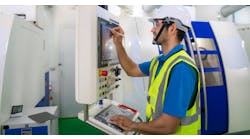Good asset management is the core of a well-run business, encompassing a whole-of-life plan for acquisition, control, and disposal of assets. Yet, amid the day-to-day imperatives of business management, it is easy to fall prey to operational priorities that distract from an optimized asset management strategy. Organizations make six common errors which, if identified and rectified, can lower the total cost of asset ownership, minimize capital spend, and optimize asset efficiency.
1. Focusing solely on operational costs
It's understandable for an organization under financial pressures to focus on monthly and annual budgets. Yet, when cutting operational spending, maintenance budgets often receive attention as the impacts of uncompleted planned maintenance are not immediately manifested. Short-term thinking like this reduces asset life while increasing total ownership costs.
Understanding how the maintenance budget fits with overall asset longevity and availability is important. Target service levels, average availability, failure modes, and maintainability should be calculated. Finance will determine a funding strategy and factor replacement costs into the capital plan. The maintenance plan should be based on original equipment manufacturers' data and in-service experience.
Adherence to the plan is critical to a successful optimal asset management system. Failing to maintain the asset as planned impacts future business efficiency through lower equipment availability, higher maintenance and inventory costs, and shortened asset life.
2. Maintaining an asset once it breaks
Maintaining an asset once its output quality reduces or stops is known as reactive maintenance. If implemented as a considered strategy after all the disadvantages are understood and accepted, it has a limited and specific place in the maintenance hierarchy. However, businesses should be clear that maintenance costs under such a strategy can be three to ten times more than those under a planned corrective maintenance program, with equipment failure being the cause of 42 percent of equipment failure.
Machine efficiency can drop for extended periods before the fault manifests in stoppage or defective output, affecting operation speeds and consuming more power. Repair costs are higher because parts have worn out beyond economical repair, emergency technician call-outs are expensive, and asset life expectancy is reduced. For production, unexpected stoppages are costly and inconvenient.
Implementing a corrective maintenance strategy supported by manufacturer's data and tuned to the needs of your business needs and those of the asset will pay dividends by maximizing asset life, delaying capital spending, and minimizing financing costs.
3. Lack of data-driven decision making
Planning an asset purchase uses the manufacturer's data and in-service experience to make financial assumptions. Yet, when the asset is installed and the maintenance plan set, many businesses fail to monitor and compare actual in-service results to the original projections.
Initial acquisition planning should identify the data collection and monitoring systems needed to adequately control the asset's performance. Sensors and a modern computerized maintenance management system (CMMS) combine to optimize monitoring and managing the asset throughout its life, allowing modifications to asset management and maintenance strategies to meet planned availability targets, assisting the asset to reach its full economic life.
4. Buying an asset on cost alone
Businesses can make purchase decisions based on capital expenditure and financing requirements. Yet, buying an asset with poor maintainability and operability imposes huge operating costs. This mistake then compounds as the demand for a reduction in operating costs drives a business to find savings in the maintenance budget, as discussed previously.
Asset pre-purchase analysis should include the whole-of-life support costs for the equipment, including tooling, training, spares, and asset disposal. If the asset is cheap but requires expensive test equipment and suffers from poor maintainability, affecting uptime, the operational costs outweigh any purchase price reductions.
5. Not understanding asset criticality
Viewing an asset in isolation from the greater productive efficiency of the operation impacts operational costs. Businesses find themselves over- or under-maintaining an asset if its criticality is unclear or its impact on productive capacity is not considered.
Over-maintaining equipment wastes financial resources and causes unnecessary downtime. Undermaintaining an asset saves some money in the short term, but the medium to long-term cost and availability implications can be prohibitive.
When incorporating an asset into an operation or adjusting a maintenance plan, carrying out a Failure Mode Effects and Criticality Analysis (FMECA) allows a business to model failures and apply mitigations. These can range from adjusting a maintenance program, to increasing equipment redundancy, or modifying inventory policies.
6. Maintaining to budget, not outcomes
Many organizations outsource equipment maintenance, choosing to focus on their core capabilities and not maintain a maintenance department. Some believe they have shifted risk to the contractor and screw them down on costs to the point of pain. However, when the contractor begins looking for margin in the contract, inevitably he will cut corners.
Then we learn the costly lesson: risk always stays with the client as production suffers and contractual arguments ensue.
When outsourcing maintenance, we should consider two issues. We need to approach any contractual relationship as a partnership, where both parties gain from improvements in asset health and availability and feel financial pain from the inverse. Then, we ensure our chosen contractor has a firm understanding of the total cost of asset ownership principles.
Choosing a contractor with the sophistication to support a culture of continuous improvement and agreeing to clear service level expectations, we now have a partnership of equals to ensure asset optimization. A few carefully identified key performance indicators support regular maintenance review and audits, where pain-sharing and gain-sharing can create focus on the outcomes the operation needs for maximum efficiency.
Clever asset management keeps the larger asset picture in mind even when faced with daily operational constraints. Like compound interest, the long-term benefits that accrue to businesses from broad, strategic asset management include reduced capital spending and reduced total costs of asset ownership. Over the life of an asset, these gains slowly and surely build up to a highly competitive edge for manufacturers and service providers.
Bryan Christiansen is the founder and CEO of Limble CMMS. Limble is a modern, easy-to-use mobile CMMS software that takes the stress and chaos out of maintenance by helping managers organize, automate, and streamline their maintenance operations.






